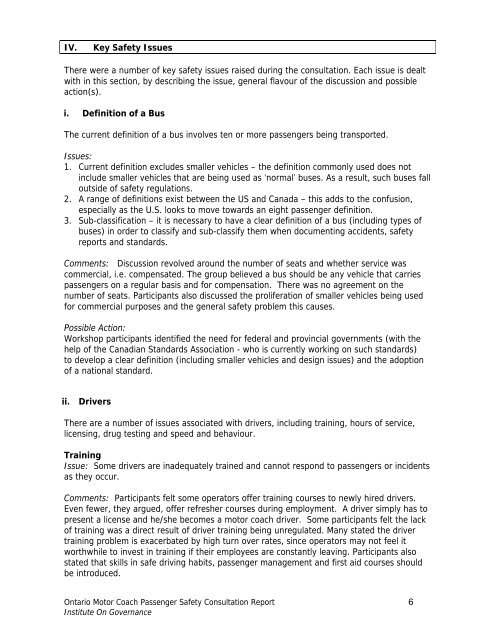Ontario Motor Coach Passenger Safety Consultation - Report -
Ontario Motor Coach Passenger Safety Consultation - Report -
Ontario Motor Coach Passenger Safety Consultation - Report -
You also want an ePaper? Increase the reach of your titles
YUMPU automatically turns print PDFs into web optimized ePapers that Google loves.
IV.<br />
Key <strong>Safety</strong> Issues<br />
There were a number of key safety issues raised during the consultation. Each issue is dealt<br />
with in this section, by describing the issue, general flavour of the discussion and possible<br />
action(s).<br />
i. Definition of a Bus<br />
The current definition of a bus involves ten or more passengers being transported.<br />
Issues:<br />
1. Current definition excludes smaller vehicles – the definition commonly used does not<br />
include smaller vehicles that are being used as ‘normal’ buses. As a result, such buses fall<br />
outside of safety regulations.<br />
2. A range of definitions exist between the US and Canada – this adds to the confusion,<br />
especially as the U.S. looks to move towards an eight passenger definition.<br />
3. Sub-classification – it is necessary to have a clear definition of a bus (including types of<br />
buses) in order to classify and sub-classify them when documenting accidents, safety<br />
reports and standards.<br />
Comments: Discussion revolved around the number of seats and whether service was<br />
commercial, i.e. compensated. The group believed a bus should be any vehicle that carries<br />
passengers on a regular basis and for compensation. There was no agreement on the<br />
number of seats. Participants also discussed the proliferation of smaller vehicles being used<br />
for commercial purposes and the general safety problem this causes.<br />
Possible Action:<br />
Workshop participants identified the need for federal and provincial governments (with the<br />
help of the Canadian Standards Association - who is currently working on such standards)<br />
to develop a clear definition (including smaller vehicles and design issues) and the adoption<br />
of a national standard.<br />
ii. Drivers<br />
There are a number of issues associated with drivers, including training, hours of service,<br />
licensing, drug testing and speed and behaviour.<br />
Training<br />
Issue: Some drivers are inadequately trained and cannot respond to passengers or incidents<br />
as they occur.<br />
Comments: Participants felt some operators offer training courses to newly hired drivers.<br />
Even fewer, they argued, offer refresher courses during employment. A driver simply has to<br />
present a license and he/she becomes a motor coach driver. Some participants felt the lack<br />
of training was a direct result of driver training being unregulated. Many stated the driver<br />
training problem is exacerbated by high turn over rates, since operators may not feel it<br />
worthwhile to invest in training if their employees are constantly leaving. Participants also<br />
stated that skills in safe driving habits, passenger management and first aid courses should<br />
be introduced.<br />
<strong>Ontario</strong> <strong>Motor</strong> <strong>Coach</strong> <strong>Passenger</strong> <strong>Safety</strong> <strong>Consultation</strong> <strong>Report</strong> 6<br />
Institute On Governance
















